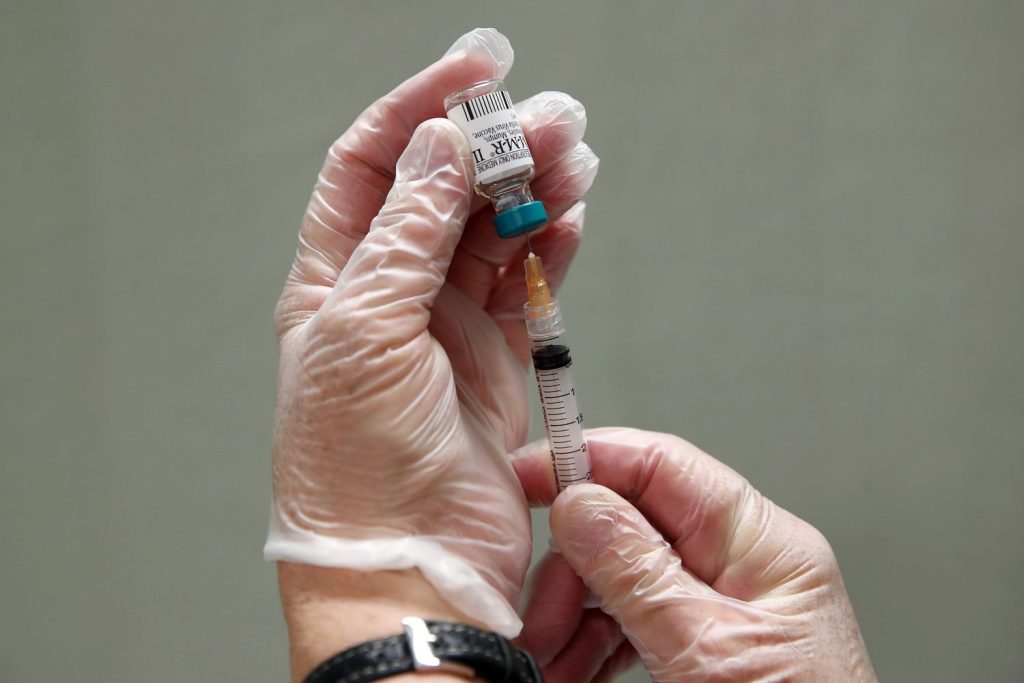:max_bytes(150000):strip_icc():format(jpeg)/VWH-GettyImages-1173494784-bf83d3179ff34d65a750c1f0f232b4a3.jpg)
At least 58 people in western Texas have been diagnosed with measles in the past three weeks, driving concerns about the resurgence of a disease declared eradicated in the United States 25 years ago.
“This is the largest measles outbreak that Texas has experienced in more than 30 years. It’s behaving like most of the recent measles outbreaks in the United States, where a case of measles is probably imported into a very vulnerable population, and then it takes off like wildfire,” said Luis Ostrosky-Zeichner, MD, a professor of medicine and epidemiology and chief of the Division of Infectious Diseases of the University of Texas McGovern Medical School.
Four of the patients are vaccinated, while the rest are either unvaccinated or their vaccination status is unknown, according to the Texas Department of State Health Services. Most cases are in children ages 5 to 17, and 13 patients have been hospitalized so far.
In neighboring New Mexico, eight measles cases have been reported in a county bordering the outbreak in Texas. “While a connection to the Texas outbreak is suspected, it remains unconfirmed,” the New Mexico Department of Health said last week in a statement.
The risk of measles transmission may be increasing in other parts of the country, too. As of Feb. 6, the Centers for Disease Control and Prevention (CDC) reported cases in five states: Alaska, Georgia, New York City, Rhode Island, and Texas.
Measles is a highly contagious disease with the potential to cause disability and death. To prevent outbreaks, 95% of people in a community must be vaccinated. Vaccination rates in the U.S. vary by region. Overall, the country has fallen below this threshold in the last three years.
In Gaines County, the epicenter of the Texas outbreak, almost 18% of school-age children have claimed exemptions from at least one vaccine.
“In some ways, the outbreak of measles in Texas is not unexpected, and I’m afraid that it may be a harbinger of what’s to come should measles cases continue to increase globally and should measles vaccination coverage here in the United States decline further,” said William John Moss, MD, MPH, professor and executive director of the International Vaccine Access Center at Johns Hopkins University.
Waning Vaccination Rates Pave the Way for Outbreaks
Measles is one of the most transmissible diseases in the world. The virus is airborne and can linger in an indoor space for up to two hours. Nine out of 10 people without immunity who come in contact with someone who has measles will become infected.
“If you go to a movie theater and somebody with measles was there within the last two to four hours, everybody who’s vulnerable is going to get it,” Ostrosky-Zeichner said. “Just being in the same room with a person with measles, if you’re not immune, you are going to get it.”
Over the last five years, several states have loosened vaccination restrictions for school-age children, allowing more families to opt out of routine childhood vaccinations. In the 2023–2024 school year, more than 3% of students in 31 states had claimed an exemption from the MMR vaccine, up from 21 states four years prior, according to KFF.
When an infected person enters a community where people have high immunity, measles transmission is unlikely. “It’s like there’s no tinder for the fire to catch,” Moss said.
“Many of these clusters of susceptible individuals remain invisible until an infectious individual enters that community, and then you get an outbreak,” Moss said. “We have some mapping of vaccine coverage, but I’m concerned that with the cuts at the CDC, maybe even some censoring, that that information is going to be even more difficult to obtain.”
Unlike COVID-19 and flu, which pose the highest risk of severe illness to the youngest and oldest populations, measles can be dangerous to people of all ages.
The measles mortality rate is low—about one to three in 1,000 cases result in death. However, the complications can be severe. About one in five people with measles require hospitalization, one in 20 children develop pneumonia, and one in 1,000 develop encephalitis (brain inflammation). The disease can also lead to a very rare but fatal neurological complication that affects the nervous system years after an acute measles infection.
The number of measles cases this year remains low, as does the risk of death. However, Ostrosky-Zeichner said that even small outbreaks can strain health systems.
“The more people with measles, the more severe outcomes we’re going to see, and that has the potential to strain hospitals. When we end up with a case of measles in the hospital, it’s kind of a big deal because there are exposures to healthcare workers and other patients in the hospital as well. It’s super time-consuming when a case of measles shows up at your doorstep,” he said.
What to Know About the MMR Vaccine
The two-dose MMR vaccine offers strong protection against measles. The vaccine is about 93% effective after the first dose and 97% effective after the second. That immunity lasts through adulthood.
While the COVID and flu viruses can quickly mutate to evade immunity, the measles virus has remained pretty much unchanged since the mid-1950s.
“If you’re vaccinated, you have absolutely nothing to worry about,” Ostrosky-Zeichner said. “If you’re not vaccinated, I think this is a time to consider vaccination. The vaccines are very safe, very effective, and they really avoid this chain of events that can lead to severe outcomes like dying or ending up with a disability.”
Children typically receive the first dose at 12 to 15 months old and their second dose at 4 to 6 years old. People who travel abroad or live in a place with a local outbreak may get their second dose sooner.
The second dose is important, Moss said, because about 5% of people don’t respond to the first dose of vaccine.
The vaccine uses a weakened version of the measles virus, so it is not recommended for people who are severely immunocompromised or pregnant. Ostrosky-Zeichner said it’s particularly important that community vaccination levels are high to protect people who cannot be vaccinated.
“What happens with a disease like measles here in the U.S. is that parents don’t see it, they don’t hear about it, they think it’s a disease that’s gone. They tend to underestimate the risk of the disease and overestimate the risk of the vaccine. That’s exacerbated by a lot of misinformation and disinformation, particularly around measles vaccines and autism,” Moss said.
What Are the Symptoms of Measles?
Some of the early symptoms of measles resemble the flu, including a high-grade fever, dry cough, runny nose, and congestion. Some people may also experience sensitivity to light, poor appetite, and the appearance of small, red spots inside the mouth.
Within one to three weeks after exposure, a red, splotchy rash will appear. The rash tends to start at the hairline and spread down the body. The patient is contagious from four days before the rash develops to four days after it appears.
“The vast majority of physicians who are practicing in the U.S. currently have not seen a case of measles, so we’re doing a lot of education for physicians,” Ostrosky-Zeichner said.
A person with symptoms of measles should wear a mask and stay isolated. If you think you’ve been exposed, limit your contact with other people and consult a healthcare provider about getting tested.
If you suspect a measles infection in your child, call ahead or schedule a telemedicine appointment to describe the symptoms before visiting a clinic or emergency room. That can help minimize exposure for others in the waiting room.
What This Means For You
You can get the MMR vaccine at any age. If you haven’t been vaccinated or are unsure of your vaccination status, talk with a health provider about your options. The vaccine schedule is flexible. If you live in an area with a measles outbreak and your child has not yet had both doses of vaccine, your health provider may accelerate the vaccine schedule to ensure they’re immune.








